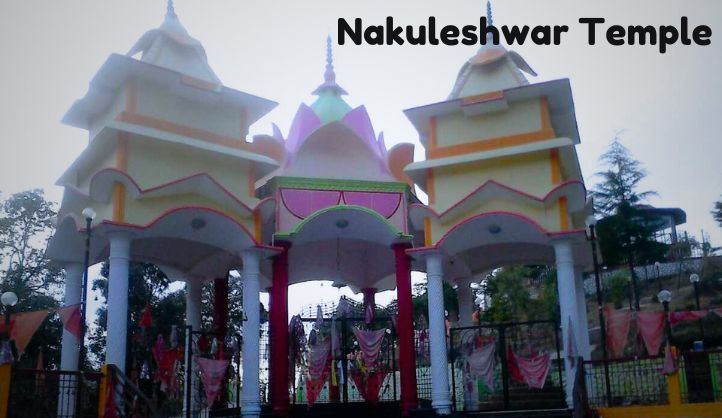Nestled amidst the serene landscapes of Pithoragarh, Uttarakhand, lies a gem of spiritual heritage – the Nakuleshwar Temple. Surrounded by majestic Himalayan peaks and lush greenery, this ancient temple is not just a place of worship but a haven for seekers of tranquility, history enthusiasts, and nature lovers alike. In this article, we embark on a virtual journey to unravel the mystique of Nakuleshwar Temple and discover why it stands as a symbol of cultural richness and spiritual significance.
A Glimpse into History
The history of Nakuleshwar Temple is as intriguing as its picturesque location. Believed to be built during the medieval period by the Chand rulers, this temple is dedicated to Lord Shiva. The architecture reflects the traditional Kumaoni style, characterized by intricately carved wooden structures and stone masonry. Legends shroud the origins of the temple, with folklore narrating tales of Nakul, one of the Pandava brothers from the epic Mahabharata, meditating at this sacred site.
Over the centuries, Nakuleshwar Temple has witnessed the ebb and flow of dynasties, yet it has remained steadfast in its spiritual allure. Pilgrims from far and wide flock to this divine abode, seeking solace and blessings from Lord Shiva, the presiding deity.
A Spiritual Odyssey
Visiting Nakuleshwar Temple is not merely a physical journey; it is a spiritual odyssey that transcends time and space. As you ascend the stone-paved path leading to the temple, a sense of reverence envelops you, accompanied by the melodic chants of ancient hymns echoing through the mountains.
The sanctum sanctorum of the temple houses a sacred Shiva Lingam, adorned with flowers and offerings from devotees. The aroma of incense permeates the air, creating an atmosphere of purity and devotion. Pilgrims engage in rituals and prayers, seeking blessings for prosperity, health, and spiritual enlightenment.
The ambiance of Nakuleshwar Temple is serene yet potent, invoking a deep sense of introspection and connectivity with the divine. It is a place where time seems to stand still, allowing visitors to immerse themselves in the eternal essence of Shiva’s consciousness.
How to reach
By Air
The nearest airport to Pithoragarh is Pantnagar Airport, located approximately 250 kilometers away. From Pantnagar, you can hire a taxi or take a bus to reach Pithoragarh town. The journey from Pantnagar to Pithoragarh takes around 7-8 hours by road. Alternatively, you can fly to Delhi or Dehradun and then take a connecting flight to Pantnagar.
By Train
The nearest railway station to Pithoragarh is Kathgodam Railway Station, situated around 200 kilometers away. From Kathgodam, you can hire a taxi or take a bus to reach Pithoragarh. The journey from Kathgodam to Pithoragarh takes approximately 7-8 hours by road.
By Road
Pithoragarh is well-connected to major cities in Uttarakhand and neighboring states by road. You can either drive to Pithoragarh in your own vehicle or opt for bus services operated by Uttarakhand Roadways and private operators. Regular buses ply between Pithoragarh and cities like Delhi, Dehradun, Haldwani, and Almora. The road journey offers scenic views of the Himalayas and picturesque valleys, making it a memorable experience for travelers.
Enchantment of Nature
Beyond its spiritual significance, Nakuleshwar Temple captivates visitors with its breathtaking natural beauty. Perched atop a hill amidst verdant forests and rolling meadows, the temple offers panoramic views of the Himalayan range, including the snow-capped peaks of Nanda Devi and Panchachuli.
The journey to Nakuleshwar Temple is as enchanting as the destination itself. Trekking enthusiasts can embark on trails that meander through dense forests, echoing with the chirping of birds and the rustling of leaves. The crisp mountain air rejuvenates the soul, while the sights and sounds of nature evoke a sense of awe and wonder.
During the spring season, the surroundings come alive with vibrant hues as rhododendrons and wildflowers adorn the landscape. The monsoon brings with it a symphony of cascading waterfalls and mist-covered valleys, creating a surreal ambiance that is both mystical and enchanting.
Nearby places to explore
Pithoragarh Fort
Located in the heart of Pithoragarh town, Pithoragarh Fort is a historical monument that offers panoramic views of the surrounding valleys and mountains. Built by the Gorkhas in the 18th century, the fort houses ancient temples, cannons, and artifacts that reflect its rich heritage.
Askot Wildlife Sanctuary
Embark on a wildlife adventure at Askot Wildlife Sanctuary, situated approximately 50 kilometers from Nakuleshwar Temple. Spread over an area of 599 square kilometers, the sanctuary is home to diverse flora and fauna, including Himalayan black bears, musk deer, and snow leopards. Enjoy nature walks, birdwatching, and wildlife safaris amidst pristine wilderness.
Dhwaj Temple
Pay homage to Goddess Jayanti Devi at Dhwaj Temple, located about 20 kilometers from Nakuleshwar Temple. Perched atop a hill, the temple offers panoramic views of the Kali River valley and the surrounding Himalayan peaks. Legend has it that the temple was built by the Chand rulers to commemorate their victory over the Gorkhas.
Chandak Hill
Embark on a trekking expedition to Chandak Hill, located approximately 15 kilometers from Nakuleshwar Temple. The hill offers stunning views of the Pithoragarh town, the Kali River valley, and the snow-clad peaks of the Himalayas. The trekking trail passes through dense forests and meadows, providing an opportunity to experience the natural beauty of the region.
Jauljibi
Explore the scenic town of Jauljibi, situated at the confluence of the Kali and Gori Rivers, approximately 30 kilometers from Nakuleshwar Temple. Known for its vibrant markets and cultural diversity, Jauljibi is a melting pot of traditions and customs. Visit the local bazaars to shop for traditional handicrafts, spices, and woolen garments.
Thal Kedar
Discover the ancient village of Thal Kedar, located about 25 kilometers from Nakuleshwar Temple. The village is renowned for its historic temples dedicated to Lord Shiva, including the Kedar Temple and the Dharmeshwar Mahadev Temple. Immerse yourself in the spiritual ambiance of these sacred sites and witness the traditional rituals performed by the local priests.
Abbott Mount
Experience tranquility at Abbott Mount, a serene hill station situated approximately 60 kilometers from Nakuleshwar Temple. Surrounded by pine and oak forests, Abbott Mount offers breathtaking views of the Himalayan peaks and the picturesque countryside. Explore the colonial-era cottages, churches, and orchards that dot the landscape, or simply relax amidst the natural beauty of the surroundings.
Preserving Heritage, Inspiring Devotion
In a world characterized by rapid modernization and urbanization, places like Nakuleshwar Temple serve as custodians of cultural heritage and spiritual legacy. The temple stands as a testament to the enduring faith of generations past and present, bridging the gap between tradition and modernity.
Efforts to preserve and protect Nakuleshwar Temple are underway, with initiatives aimed at conserving its architectural marvels and natural surroundings. Local communities actively participate in the upkeep of the temple, ensuring that its sanctity remains untarnished for future generations to cherish.
Conclusion
Nakuleshwar Temple in Pithoragarh stands as a beacon of spirituality and heritage, beckoning travelers to embark on a journey of self-discovery and divine communion. Its ancient walls resonate with echoes of prayers and hymns, while its natural surroundings inspire awe and reverence.
For those seeking respite from the rigors of everyday life, Nakuleshwar Temple offers a sanctuary of peace and tranquility. It is a place where the mundane fades into insignificance, and the eternal essence of the divine reigns supreme.
FAQs about Nakuleshwar Temple
Where is Nakuleshwar Temple located?
Nakuleshwar Temple is located in Pithoragarh district, Uttarakhand, India. It is situated atop a hill, offering panoramic views of the surrounding Himalayan peaks.
What is the significance of Nakuleshwar Temple?
Nakuleshwar Temple is dedicated to Lord Shiva and holds immense religious significance for devotees. It is believed to have been built during the medieval period by the Chand rulers and is associated with the legend of Nakul, one of the Pandava brothers from the Mahabharata.
What is the architecture of Nakuleshwar Temple like?
The temple features traditional Kumaoni architecture, characterized by intricately carved wooden structures and stone masonry. It has a sanctum sanctorum housing a Shiva Lingam, along with ornate carvings and sculptures depicting Hindu deities and mythological figures.
How can I reach Nakuleshwar Temple?
Nakuleshwar Temple can be reached via a trekking trail or by road. The nearest town is Pithoragarh, from where visitors can hire taxis or use public transport to reach the temple. The journey involves ascending a hill, offering scenic views along the way.
Is there accommodation available near Nakuleshwar Temple?
While there are limited accommodation options near the temple, visitors can find guesthouses, lodges, and hotels in Pithoragarh town. It is advisable to plan accommodation, especially during peak tourist seasons.
What are the best times to visit Nakuleshwar Temple?
The temple can be visited throughout the year, but the best times to visit are during the spring and summer months (March to June) when the weather is pleasant and the surroundings are lush and vibrant. Monsoon season (July to September) offers a unique experience with lush greenery and cascading waterfalls, while winter (October to February) provides clear views of the snow-capped Himalayan peaks.
Are there any trekking opportunities near Nakuleshwar Temple?
Yes, the surrounding area offers numerous trekking trails that cater to varying difficulty levels. Trekking enthusiasts can explore trails that meander through dense forests, offering opportunities to experience the natural beauty of the region.
Is photography allowed inside Nakuleshwar Temple?
Yes, photography is generally allowed inside the temple premises, but visitors are advised to respect the sanctity of the place and seek permission before taking photographs of the deity or performing rituals.





